Iridescent


Almeria, city of
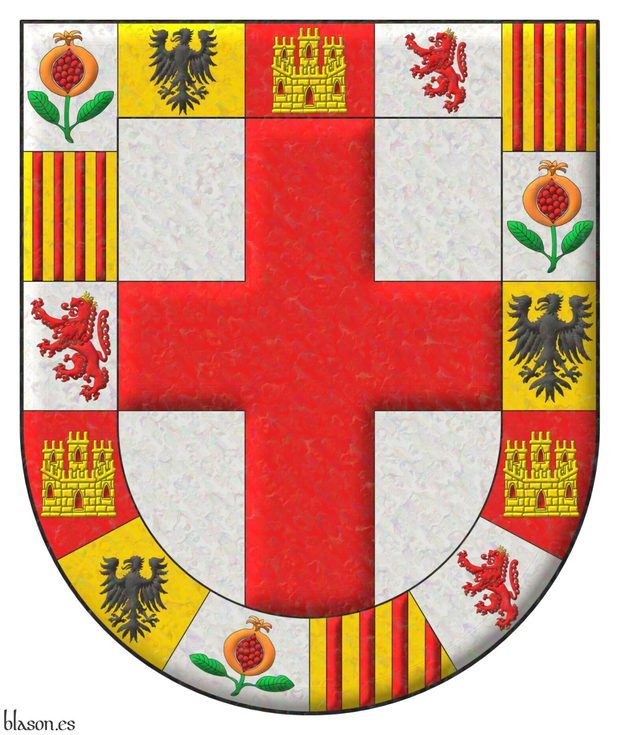
Argent, a cross Gules; a bordure compony of fifteen sections: 1, 6, and 11 Argent, a pomegranate seeded, slipped and leaved proper; 2, 7, and 12 Or, an eagle displayed Sable; 3, 8, and 13 Gules, a castle triple-towered Or, port and windows Gules, masoned Sable; 4, 9, and 14 Argent, a lion rampant Gules, crowned Or; 5, 10, and 15 Or, four pallets Gules.
Escudo de plata, una cruz de gules; una bordura componada de quince compones: 1o, 6o y 11o de plata, una granada al natural, tajada de gules, tallada y hojada de sinople; 2o, 7o y 12o de oro, un águila de sable; 3o, 8o y 13o de gules, un castillo de oro, aclarado de gules, mazonado de sable; 4o, 9o y 14o de plata, un león rampante de gules, coronado de oro; 5o, 10o y 15o de oro, cuatro palos de gules.
Coat of arms emblazoned by me, illuminated with lights and shadows, outlined in Sable, with a semi-circular outer contour and with a iridescent finishing.
Coat of arms of the city of Almeria, Andalusia, emblazoned by me. In 1147, during the Reconquista, the city of Almería was captured by the forces of King Alfonso VII of León, known as «the Emperor», as part of a broader crusading effort declared by Pope Eugene III. The conquest came in response to the Almohad invasion of 1146, which had begun with a landing in Algeciras and quickly seized key territories in the south of the Iberian Peninsula. In reaction, Alfonso VII negotiated an alliance with the Almoravid leader Ibn Ganiya to organize a resistance. He met with Ramon Berenguer IV, Count of Barcelona, and García Ramírez of Navarre, and together they planned the assault on Almería, which at the time was under Almoravid control. Crucial to the success of the operation was the support of the powerful Genoese navy, as well as French crusaders who had responded to the papal call. Subsequently, in recognition of Genoa’s decisive role in the campaign, Almería adopted as the central element of its coat of arms the Genoese emblem: «Argent, a cross Gules».
Blazon keywords: Argent, Gules, Or, Sable, Vert, One, Four, Fifteen, Cross, Bordure, Compony, Pomegranate, Slipped, Leaved, Proper, Eagle, Castle, Triple-towered, Port and windows, Masoned, Lion, Rampant, Crowned and Pallet.
Style keywords: Outlined in sable, Illuminated, Semi-circular and Iridescent.
Classification: Civic, Interpreted, Boa and Coat of arms.
Bearer: Almeria, city of.


Arms of Del Fabbro Universidad with its motto above the arms
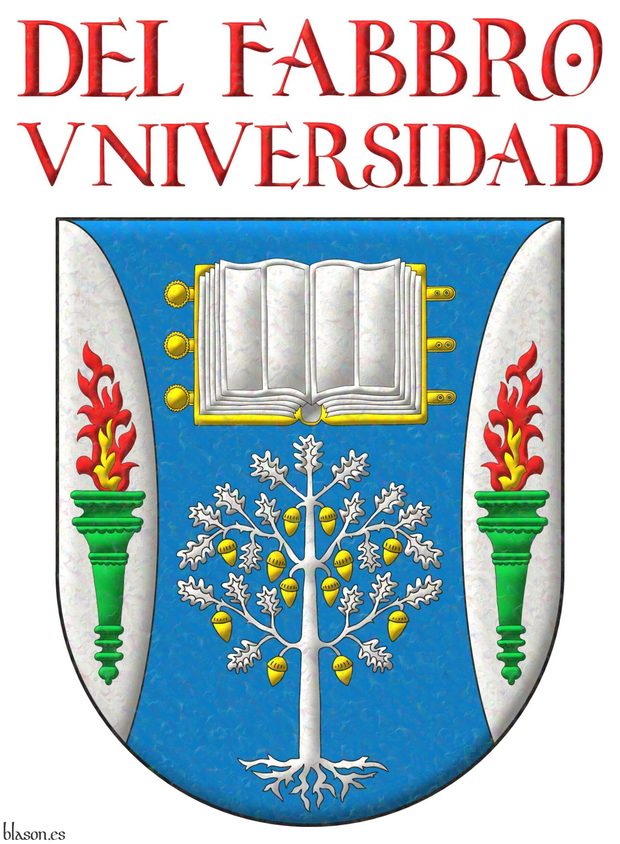
Azure, flanched Argent: in chief, an open book Argent, garnished Or; in base, an oak eradicated Argent, fructed Or; in each flank, a torch Vert, enflamed proper. Motto above the arms: «Del Fabbro Universidad» Gules.
Escudo de azur, flanqueado curvo de plata: en jefe, un libro abierto de oro, hojado de plata; en punta, un roble arrancado de plata, frutado de oro; en cada flanco, una antorcha de sinople, encendida al natural. Divisa sobre el escudo: «Del Fabbro Universidad» de gules.
Coat of arms designed by me, illuminated with lights and shadows, outlined in Sable, with a semi-circular outer contour and with a iridescent finish.
Blazon keywords: Azure, Argent, Or, Vert, One, Two, Flanched, In chief, Open book, Book, Garnished, In base, Oak, Tree, Eradicated, Fructed, In each flank, Torch, Enflamed, Proper, Motto (identification) and Above the shield.
Style keywords: Outlined in sable, Illuminated, Semi-circular and Iridescent.
Classification: Socioeconomic, Created, Boa and Coat of arms.
Bearer: Del Fabbro Universidad.


Arms of Felipe VI of Spain with the Order of the Garter
![Arms of Felipe VI of Spain with the Order of the Garter Quarterly: 1 Gules, a castle triple-towered Or, port and windows Azure, masoned Sable [for Castile]; 2 Argent, a lion rampant Purpure, armed and langued Gules, crowned Or [for Leon]; 3 Or, four pallets Gules [for Aragon]; 4 Gules, a chain orlewise, crosswise, and saltirewise Or, charged in the fess point with an emerald Vert [for Navarre]; enté en point Argent, a pomegranate proper, seeded Gules, slipped and leaved Vert [for Granada]; an inescutcheon Azure, three fleurs de lis Or, 2 and 1, a bordure Gules [for Bourbon]. Crest: A closed royal crown. The shield is surrounded by the Most Noble Order of the Garter.](../escudo_armas/FelipeVI.41.GarterMno.Corona.Irisado.Avr25.jpg)
Quarterly: 1 Gules, a castle triple-towered Or, port and windows Azure, masoned Sable [for Castile]; 2 Argent, a lion rampant Purpure, armed and langued Gules, crowned Or [for Leon]; 3 Or, four pallets Gules [for Aragon]; 4 Gules, a chain orlewise, crosswise, and saltirewise Or, charged in the fess point with an emerald Vert [for Navarre]; enté en point Argent, a pomegranate proper, seeded Gules, slipped and leaved Vert [for Granada]; an inescutcheon Azure, three fleurs de lis Or, 2 and 1, a bordure Gules [for Bourbon]. Crest: A closed royal crown. The shield is surrounded by the Most Noble Order of the Garter.
Arms emblazoned by me, highlighted with lights and shadows, contoured in Sable, with a semi-circular external shape and with a iridescent finish.
Coat of arms of His Majesty the King Felipe VI, Kingdom of Spain, emblazoned by me. Queen Elizabeth II invested His Majesty King Felipe VI as a Knight of the Most Noble Order of the Garter on 17 June 2019 at St George’s Chapel, Windsor Castle.
Blazon keywords: Gules, Azure, Purpure, Vert, Or, Argent, One, Three, Four, Quarterly, Castle, Triple-towered, Port and windows, Masoned, Lion, Rampant, Crowned, Pallet, Chain, In orle, In cross, In saltire, Charged, Emerald, In the fess point, Proper, Pomegranate, Slipped, Leaved, Inescutcheon, Fleur de lis, Ordered, Bordure, Closed royal crown, Crown, Surrounded and Collar.
Style keywords: Outlined in sable, Illuminated, Semi-circular and Iridescent.
Classification: Personal, Kingdom of Spain, Interpreted, Boa and Coat of arms.
Bearer: Felipe VI of Spain.


Badge Rick Kasparek

A sea-griffin erect Sanguine, membered, beaked, nimbed, dorsal and tail fins Or, langued Azure, grasping in its talons a mullet of eight points Or.
Heraldic device painted by me, highlighted with lights and shadows, contoured in Sable, and with a iridescent finishing.
Heraldic badge of Rick Kasparek emblazoned by me.
Blazon keywords: Sanguine, Or, Azure, One, Eight, Sea-griffin, Erect, Membered, Beaked, Nimbed, Dorsal fin, Tail fin, Langued, Grasping, Talon and Mullet.
Style keywords: Outlined in sable, Illuminated and Iridescent.
Classification: Personal, Interpreted, Boa and Badge.
Bearer: Kasparek, Rick.


Bosnia and Herzegovina

From 1992 to 1998
Azure, a bendlet Argent between six fleurs de lis Or.
Illuminated with lights and shadows and with a metallic and iridescent finish.
Coat of arms of Stephen Tvrtko I (circa 1338-1391) of the House of Kotromanic and 1st King of Bosnia and it was also the coat of arms of Bosnia and Herzegovina from 1992 to 1998.
The bendlet is a diminutive of the bend. It is a diminished bend, narrower, and typically reduced to 1/2 (as in this case) or to 1/3 of the width of a normal bend. This piece is called «cotiza» in Castilian, «cotice» in French, and «cotissa» in Italian. Remember that the width of the bend is usually 1/3 of the width of the coat of arms, therefore the width of the bendlet is between 1/3 * 1/2 = 1/6 and 1/3 * 1/3 = 1/9 of the width of the coat of arm.
Stephen Tvrtko I of Bosnia, from the House of Kotromanic, was a vassal of Louis I of Hungary. Louis I or Louis of Anjou, known as «the Great», from the Royal House of Anjou-Sicily, of the Capetian Dynasty, hence his coat of arms's 2nd quarter is seeded with fleur de lis, a feature also present in his father Charles I's arms, known as Charles Robert or Caroberto of Anjou. The Kotromanic family had in their coat of arms fleur de lis Or on a Azure field as a symbol of subordination to the Hungarian royal family.
Blazon keywords: Azure, One, Bendlet, Argent, Six, Fleur de lis and Or.
Style keywords: Metal beaten, Iridescent, Outlined in sable, Illuminated and Pointed.
Classification: Civic, Interpreted and Coat of arms.
Bearer: Bosnia and Herzegovina.


Castile and León, framed
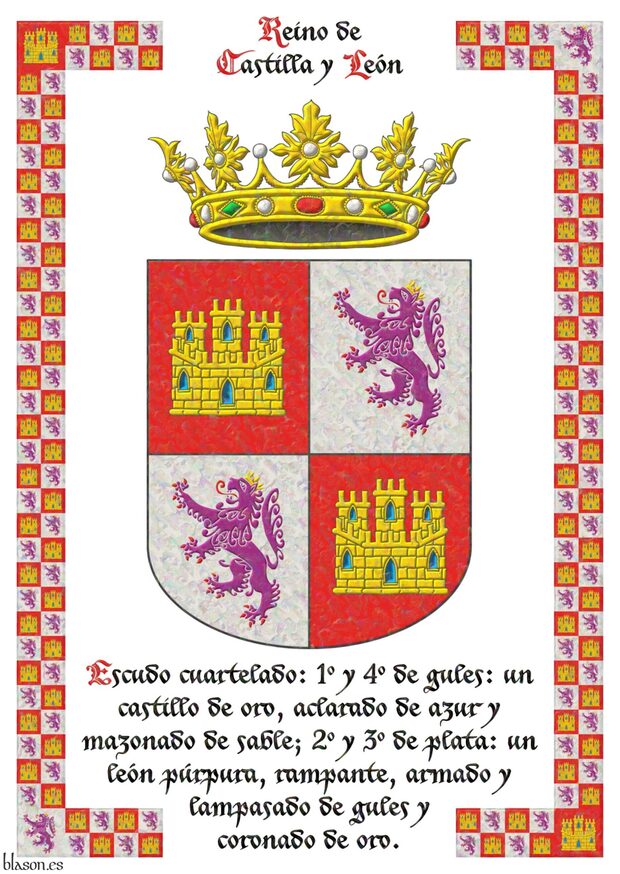
Quarterly: 1 and 4 Gules, a castle triple towered Or, port and windows Azure, masoned Sable; 2 and 3 Argent, a lion rampant Purpure, armed and langued Gules, crowned Or. Crest: An open royal crown Or.
Escudo cuartelado: 1o y 4o de gules, un castillo de oro, aclarado de azur, mazonado de sable; 2o y 3o de plata, un león rampante de púrpura, armado y lampasado de gules, coronado de oro. Timbrado de una corona real abierta.
Arms of the Kingdom of Castile and León created by me as follows: the shield of arms has a rounded (semicircular) base; the quarters are illuminated in flat tinctures Argent and Gules; the castles, lions and crown are illuminated; the lion and its crown are outlined in the colour of the field; the open royal crown; the royal Castilian castle is masoned, that is, outlined in Sable; the whole has an iridescent finish; and the owner, the shield and its blazon are framed within a border representing the arms of the Kingdom, this frame resulting from the combination of 76 small castles and 2 large ones at the corners with 76 small crowned lions and 2 large lions at the other corners;
In the armorial [Urfé; 15th century; page VIII of the index and page 140 of the contents], reference is made to and the arms of Castile and its kings are blazoned in French, describing its castle and its purple lion crowned Or and rampant.
Blazon keywords: Quarterly, Gules, Or, Azure, Sable, One, Castle, Port and windows, Masoned, Argent, Purpure, Lion, Rampant, Armed, Langued, Crowned, Crest, Open royal crown and Crown.
Style keywords: Rounded, Illuminated and Iridescent.
Classification: Interpreted, Civic, Frame, Kingdom of Castile and Leon and Canting.
Bearer: Castile and León.


Cavalry Regiment Alcantara, Laureate of Saint Ferdinand
Grand Laureate Cross of Saint Ferdinand.
Argent, a cross of Alcantara. Crest: A closed royal crown Or, with eight arches, visible five. Behind the shield the Laureate Grand Cross of Saint Ferdinand. Motto: «Hoec nubila tollunt obstantia sicut sol».
Escudo de plata, una cruz de Alcántara. Timbrado de una corona real cerrada. Acolada detrás del escudo la gran cruz laureada de San Fernando. Lema: «Hoec nubila tollunt obstantia sicut sol».
Coat of arms interpreted in the following manner: the shape of the shield is of a semicircular arch; the field is illuminated in metal Argent; the cross of Alcantara, the 4 swords and the 2 laurel branches are outlined in Sable and illuminated in Vert and Gules; the royal crown is closed, outlined in Sable and illuminated with the metal Or, Argent for the pearls, Azure and Or for the orb, Gules and Vert for the gems, Gules for the inner cloth, and Sable for the visible hollow at its base; and the whole has a iridescent finish.
Rif War, July 23, 1921, banks of the Igan River, North Africa
The Alcantara Regiment executed nine successive cavalry charges to protect the infantry's retreat, nine charges until they broke the enemy lines, outnumbering them. The last charge was on foot because all their horses were dead or exhausted. These heroic riders of Alcantara had fulfilled their duty of protecting the wounded infantry in their retreat to El Batel, but the price was appalling: of 691 riders, only 67 survived, and three months were necessary to recover hundreds of corpses.
For this reason, in 2012, the Alcántara Regiment was collectively awarded the Grand Laureate Cross of Saint Ferdinand.
Two lances behind the shield
Since 1987, the coat of arms of the cavalry regiments of the Spanish Army must carry two crossed lances accolade behind the shield. And indeed, this coat of arms of the Alcántara Cavalry Regiment has two lances behind the shield, but in my artistic heraldic interpretation, I did not paint them to avoid detracting from the prominence of the Laureate Cross.
Blazon keywords: Without divisions, Argent, Cross of Alcantara, Cross couped, Cross, Crest, Closed royal crown, Crown, Behind the shield, Four, Sword, Crosswise, Gules, Two, Branch, Laurel, Vert and Motto.
Style keywords: Semi-circular, Illuminated, Outlined in sable and Iridescent.
Classification: Interpreted, Military, Army and Navy and Coat of arms.
Bearer: Alcantara, Cavalry Regiment.


Charles Dunne, Chas
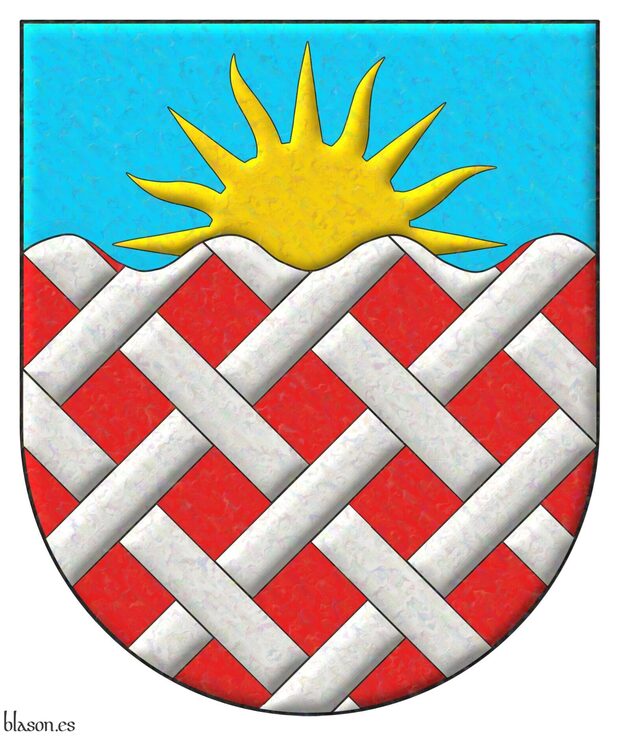
Motto: Stand and Be Counted
Gules fretty Argent; on a chief wavy Bleu celeste, a rising sun Or.
Escudo de gules fretado de plata; en un jefe ondado de celeste, un sol saliente de oro.
Coat of arms interpreted and emblazoned by me with with a semi-circular ended shape, illuminated, and with a iridescent finishing.
The sun used to be emblazoned with a human face, with its eyes, mouth, and nose, but in all the interpretations that I know of this blazon, the sun appears without a human face.
Schema for the fretty
Blazon keywords: Without divisions, Gules, Fretty, Argent, One, Chief, Wavy, Bleu celeste, Sun, Issuant and Or.
Style keywords: Iridescent, Outlined in sable, Illuminated and Semi-circular.
Classification: Interpreted.
Bearer: Charles Dunne, Chas.


Charles VII of France
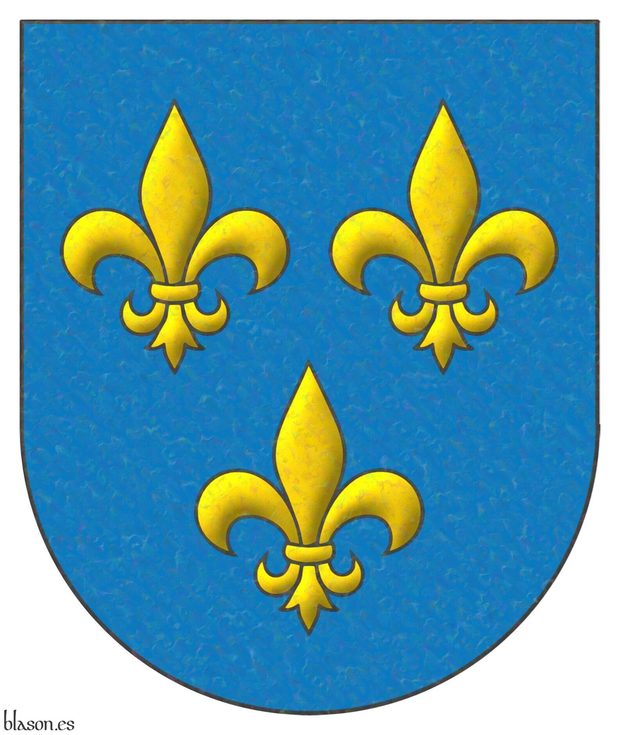
King of France from 1429 to 1461.
Azure, three fleurs de lis Or.
Escudo de azur, tres flores de lis de oro.
Coat of arms interpreted with: a semicircular (round) base; the field enamelled in flat Azure; the fleurs-de-lis illuminated in Or and outlined in Sable; and finished with a mother-of-pearl effect.
This coat of arms is based on the one appearing in the armorial [Ingeram, H.; 1459; page 34, 1st shield], under the inscription «küng von franckrich» (franckrich ~ Frankreich ~ France).
Blazon keywords: Without divisions, Azure, Or, Three, Fleur de lis and Ordered.
Style keywords: Semi-circular, Illuminated, Outlined in sable and Iridescent.
Classification: Interpreted, Personal, Coat of arms, Kingdom of France and House of Valois.
Bearer: Charles VII of France.


Closed royal crown and the Comunidad de Madrid
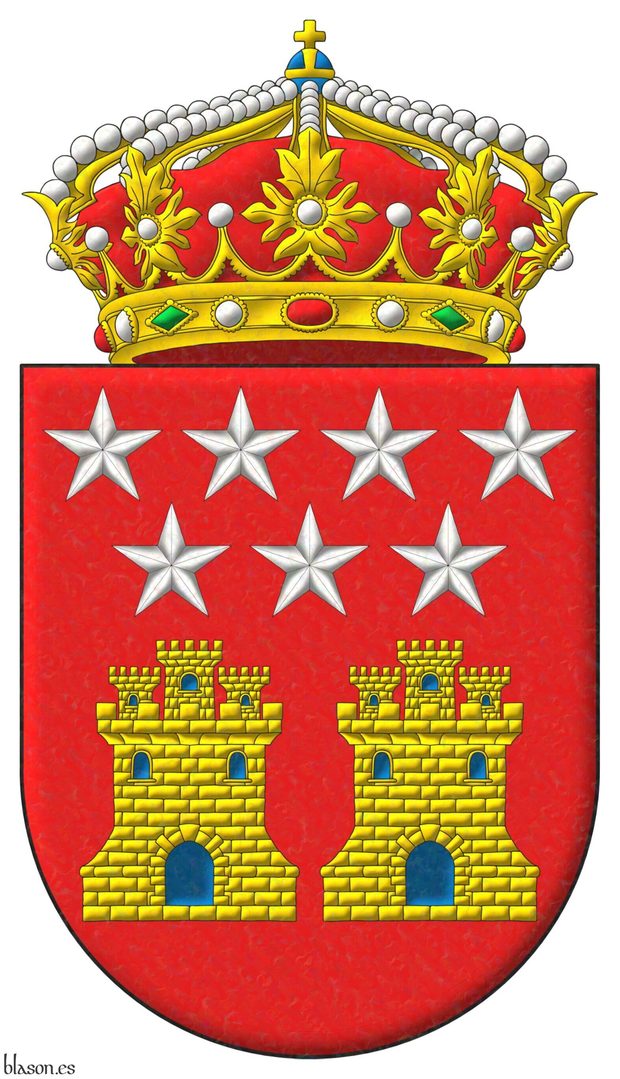
Gules, two castles triple-towered Or, port and windows Azure, masoned Sable, in chief, seven mullets Argent, 4 and 3. Crest: A closed royal crown.
Arms emblazoned by me, illuminated with lights and shadows, contoured in Sable, with a semi-circular outer contour and with a iridescent finishing.
Coat of arms of the Comunidad de Madrid emblazoned by me. Law 2/1983 of 23 December on the flag, the coat of arms, and the anthem of the Community of Madrid, published in the Official State Gazette, number 33 of 8 February 1984, defines this coat of arms in its Article 2 as follows: «...it consists of a single quarter Gules, charged Or with two castles in pair, embattled, donjoned, masoned Sable and ajouré Azure, surmounted in chief by seven mullets Argent, arranged four and three. For a timbre, a closed Royal Crown, which is a circle Or set with precious stones, composed of eight acanthus-leaf fleurons, of which five are visible, interspersed with pearls, from whose leaves rise diadems topped with pearls, converging in a globe Azure, with the demi-meridian and equator Or, surmounted by a cross Or. The crown is lined Gules».
Design rationale
The castles came from Castile and the 7 mullet from the bordure of the city of Madrid, they are the stars of the Plough, the 7 brightest stars of the Ursa Major. This coat of arms was adopted by the Comunidad de Madrid the 23th of December 23 of 1983.
Blazon keywords: Gules, Or, Azure, Argent, Two, Seven, Castle, Triple-towered, Port and windows, Masoned, In chief, Mullet, Closed royal crown and Crown.
Style keywords: Outlined in sable, Illuminated, Semi-circular and Iridescent.
Classification: Civic, Interpreted, Boa and Coat of arms.
Bearer: Madrid, Comunidad de.


Coat of arms of Noelia Yñigo-Genio

Or, a double rose Gules and Argent, barbed Vert, and seeded Or within six fleurs de lis in orle, five Gules and one in chief Azure.
Escudo de oro, una rosa doble de gules y plata, barbada de sinople y botonada de oro, rodeada de seis flores de lis en orla, cinco de gules y una de azur en jefe.
Credits:
- Rolando Yñigo-Genio is the designer of the coat of arms.
- Antonio Salmerón y Cabañas is the author of the heraldic art.
Blazon keywords: Or, Double rose, Gules, Argent, Barbed, Vert, Seeded, Six, Fleur de lis, Orle, Five, One, Azure and In chief.
Style keywords: Semi-circular, Iridescent, Outlined in sable and Illuminated.
Classification: Interpreted, Personal and Coat of arms.
Bearer: Yñigo-Genio, Noelia.


Columns of the Kingdom of Spain
Quarterly: 1 Gules, a castle triple-towered Or, port and windows Azure, masoned Sable [for Castile]; 2 Argent, a lion rampant Purpure, armed and langued Gules, crowned Or [for Leon]; 3 Or, four pallets Gules [for Aragon]; 4 Gules, a chain orlewise, crosswise, and saltirewise Or, charged in the fess point with an emerald Vert [for Navarre]; enté en point Argent, a pomegranate proper, seeded Gules, slipped and leaved Vert [for Granada]; an inescutcheon Azure, three fleurs de lis Or, 2 and 1, a bordure Gules [for Bourbon]. Crest: A closed royal crown. Supporters: two columns Argent, capital and base Or, between in base waves Azure, in chief an imperial crown the dexter and a closed royal crown the sinister. Moto environing the columns and behind the shield: «Plus Ultra» Or over a scroll Gules.
Coat of arms interpreted by me, highlighted with lights and shadows, contoured in Sable, with a semi-circular outer contour and with a iridescent finishing.
Arms of the Kingdom of Spain emblazoned by me. On the arrangement of the crowns: a) Royal Decree 1511/1977, of 21 January, enacted during the so-called Transition and approving the Regulations on Flags and Standards, Guidons, Insignia and Distinctive Signs, states: «Rule No. 2. Coat of Arms of Spain… Accompanied by two columns Argent, with base and capital Or, set upon waves Azure or blue and Argent», «superado» «by an imperial crown on the dexter one and by a royal crown on the sinister one…». b) The subsequent Law 33/1981, of 5 October, regulating the current coat of arms of Spain, likewise states: «…Accompanied by two columns Argent, with base and capital Or, set upon waves Azure or blue and Argent», «superado» «by an imperial crown on the dexter one and by a royal crown on the sinister one». c) The term «superado» in the heraldic dictionaries in which it appears refers, as a synonym, to «surmontado». d) The definitions of «surmontado» include: «a charge which, at its upper part, has another above it but without touching it», «also said of superado», and «a figure that bears another above it, but without touching it». In light of a), b), c) and d), the two crowns should therefore be painted not touching the columns. However, in the illustrative drawing contained in Royal Decree 1511/1977 the crowns do touch the columns, contradicting its own wording, although in heraldry, when in doubt, the written blazon always prevails; and in most official representations the crowns do indeed touch the columns. Nevertheless, this personal interpretation of both the coat of arms of Spain and of the proper way to write its blazon, where the lateral crowns do not touch the columns, and then I decide that, following the same criterion, the central crown should not touch the shield either, so the result differs from the official version. The expression «waves Azure or blue and Argent», which appears both in the 1977 official definition and in the 1981 one, presents a double peculiarity: it combines the heraldic term «Azure» with the everyday term «blue», and it is also offered as an optional blazon, giving two alternatives, that the waves be only Azure, as I have painted them, or Azure and Argent; optional blazons are extremely rare and, in my view, perhaps not very advisable.
Blazon keywords: Gules, Azure, Purpure, Vert, Or, Argent, One, Two, Three, Four, Quarterly, Castle, Triple-towered, Port and windows, Masoned, Lion, Rampant, Crowned, Pallet, Chain, Orlewise, Crosswise, Saltirewise, Charged, In the fess point, Emerald, Enté en point, Pomegranate, Proper, Slipped, Leaved, Inescutcheon, Fleur de lis, Ordered, Bordure, Closed royal crown, Crown, Supporter (thing), Supporter, Column, Shafted, Between, In base, Wave, In chief, Imperial crown, Dexter, Sinister, Motto, Environed, Behind the shield and Scroll.
Style keywords: Outlined in sable, Illuminated, Semi-circular and Iridescent.
Classification: Civic, Kingdom of Spain, Interpreted, Boa and Coat of arms.
Bearer: Spain, Kingdom of.


Crepsi
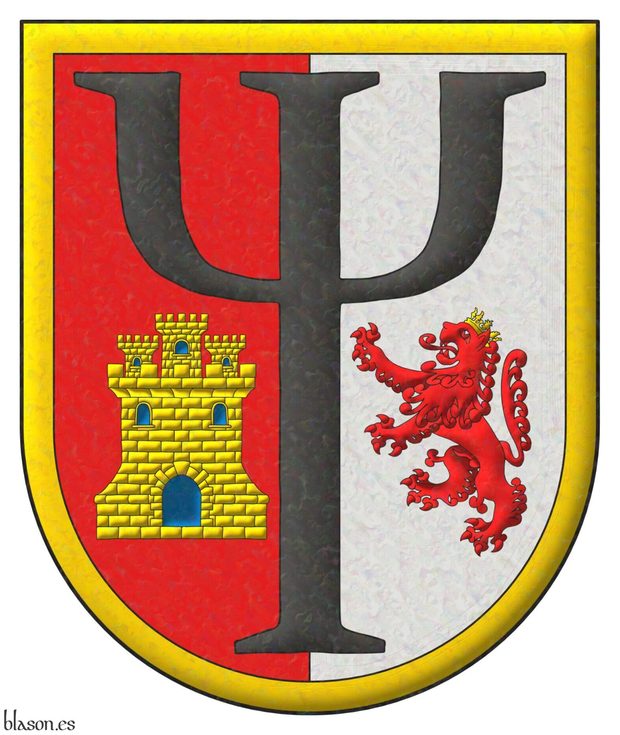
Party per pale: 1 Gules, in base a castle triple-towered Or, port and windows Azure, and masoned Sable; 2 Argent, in base a lion rampant Gules, crowned Or; overall a psi letter sable; a diminished bordure Or.
Escudo partido: 1o de gules, en punta un castillo de oro, aclarado de azur y mazonado de sable; 2o de plata, en punta un león rampante de gules, coronado de oro; brochante sobre la partición una letra psi de gules; una filiera de oro.
Coat of arms emblazoned by me, illuminated with lights and shadows, outlined in Sable, with a semi-circular outer contour and with a iridescent finishing.
Coat of arms of Crepsi, military psychology, former Central Military Region, Kingdom of Spain, where I was stationed during my military service. These arms were designed by my lieutenant colonel and friend Miguel Angel Nuñez Amador, and in this image, they have been emblazoned by me. The Crepsi was a pioneer in its functions: a) the identification of soldiers at psychological risk, among tens of thousands of soldiers, using advanced information systems, including Artificial Intelligence (an area where I contributed during my service in 1989), and b) the evaluation and individualized attention of soldiers at risk through mobile units. The Crepsi has provided trained personnel and methods that are being used for the psychological care of troops deployed to conflict zones and for the psychological care of civilians in massive humanitarian disasters such as terrorist attacks or plane crashes with hundreds of affected people.
Design rationale
The psi letter of psychology and the arms of the Central Military Region: Party per pale: 1 Gules, a castle triple-towered Or, port and windows Azure, and masoned Sable; 2 Argent, a lion rampant Gules, crowned Or. These two fields, in turn, Gules and Argent, charged with a castle triple-towered and a crowned lion, originate from the Kingdom of Castile and León. The diminished bordure is for difference.
Blazon keywords: Gules, Argent, Or, Azure, Sable, Party per pale, In base, Castle, Triple-towered, Port and windows, Masoned, Lion, Rampant, Crowned, Overall, Letter and Diminished bordure.
Style keywords: Outlined in sable, Illuminated, Semi-circular and Iridescent.
Classification: Military, Interpreted, Design rationale, Boa and Coat of arms.
Bearer: Crepsi.


Crown of Her Royal Highness Doña Leonor Princess of Asturias
![Crown of Her Royal Highness Doña Leonor Princess of Asturias Quarterly: 1 Gules, a castle triple-towered Or, port and windows Azure, masoned Sable [for Castile]; 2 Argent, a lion rampant Purpure, armed and langued Gules, crowned Or [for Leon]; 3 Or, four pallets Gules [for Aragon]; 4 Gules, a chain orlewise, crosswise, and saltirewise Or, charged in the fess point with an emerald Vert [for Navarre]; enté en point Argent, a pomegranate proper, seeded Gules, slipped and leaved Vert [for Granada]; an inescutcheon Azure, three fleurs de lis Or, 2 and 1, a bordure Gules [for Bourbon]; and the whole debruised by a label of three points Azure. Crest: A Crown of Prince. The shield is surrounded by the Golden Fleece.](../escudo_armas/LeonorPA.27.Corona.Preciosas.Toison.Irisado.jpg)
Quarterly: 1 Gules, a castle triple-towered Or, port and windows Azure, masoned Sable [for Castile]; 2 Argent, a lion rampant Purpure, armed and langued Gules, crowned Or [for Leon]; 3 Or, four pallets Gules [for Aragon]; 4 Gules, a chain orlewise, crosswise, and saltirewise Or, charged in the fess point with an emerald Vert [for Navarre]; enté en point Argent, a pomegranate proper, seeded Gules, slipped and leaved Vert [for Granada]; an inescutcheon Azure, three fleurs de lis Or, 2 and 1, a bordure Gules [for Bourbon]; and the whole debruised by a label of three points Azure. Crest: A Crown of Prince. The shield is surrounded by the Golden Fleece.
Arms depicted by me, highlighted with lights and shadows, outlined in Sable, with a semi-circular external shape and with a iridescent finish.
This is my interpretation of the coat of arms of Her Royal Highness Doña Leonor Princess of Asturias (as heiress to the Crown of Castile), Princess of Girona (as heiress to the Crown of Aragon), and Princess of Viana (as heiress to the Kingdom of Navarre), with the Collar of the Distinguished Order of the Golden Fleece. Her coat of arms is that of her father, the King, charged with a label Azure and surmounted by the crown of a princess with four pearl diadems, three visible.
Blazon keywords: Gules, Azure, Purpure, Vert, Or, Argent, One, Three, Four, Quarterly, Castle, Triple-towered, Port and windows, Masoned, Lion, Rampant, Crowned, Pallet, Chain, Orlewise, Crosswise, Saltirewise, Charged, In the fess point, Emerald, Enté en point, Pomegranate, Proper, Slipped, Leaved, Inescutcheon, Fleur de lis, Ordered, Bordure, Cadency, Label of three points, Crown of Prince, Crown, Surrounded and Collar.
Style keywords: Outlined in sable, Illuminated, Semi-circular and Iridescent.
Classification: Personal, Kingdom of Spain, Interpreted, Boa and Coat of arms.
Bearer: Leonor Princess of Asturias.


Family d’Alpoim, an arm supporting Notre Dame du Puy

Azure, five fleurs de lis Or. Crest: Upon a wreath Or and Azure, an arm Carnation, vested Azure, supporting a scroll Azure doubled Or, inscribed with the war cry «Notre Dame du Puy» Or.
Arms emblazoned by me, illuminated with lights and shadows, outlined in Sable, and with a iridescent finish.
«Armas antigas» ~ ancient arms of family d’Alpoim, originally from France, emblazoned for Fernando Durán Cabral de Mello d’Alpoim by me according to his instructions and based on descriptions from armorials such as «Nobiliário da Ilha Terceira» by Eduardo de Campos de Castro de Azevedo Soares, «Pedatura Lusitana», on the noble families of Portugal, by Cristóvão Alão de Morais, the chapter «O Solar dos Alpoins» by A. Nogueira Gonçalves, or «Armaria Portuguesa» that describes it in Portuguese «De azul, cinco flores de lis de oiro. T.: braço vestido de azul, a mão de encarnação segurando um listão tambem de azul, e nelle, em letras de oiro, o grito Nostre Dame de Puy» and also in French «D'azur à cinq fleurs-de-lis d'or. C.: un bras paré d'azur, la main de camation tenant un listel d'azur avec le cri, Nostre Dame de Puy, en lettres d'or». In the Velay region, France, the cathedral is dedicated to Our Lady under the title «Notre Dame du Puy», a Marian devotion traditionally associated with the sanctuary of Le Puy-en-Velay.
Blazon keywords: Azure, Or, Five, Fleur de lis, Crest, Upon (wreath), Wreath, Arm, Vested, Supporting, Scroll, Doubled, Inscribed and War cry.
Style keywords: Outlined in sable, Illuminated and Iridescent.
Classification: Personal, Interpreted, Boa and Coat of arms.
Bearer: d’Alpoim, family.


Halkosaari, Heikki

Argent, an apple tree, the base of its trunk forming a cross crosslet Azure, fructed Gules.
Escudo de plata, un manzano con la punta del tronco en forma de cruz recrucetada de Azur, frutado de gules.
Coat of arms painted by me, highlighted with lights and shadows, contoured in Sable, with a semi-circular external shape and with a iridescent finishing.
Blazon keywords: Argent, Azure, Gules, One, Apple tree, Base, Trunk, Cross, Crosslet, Cross couped and Fructed.
Style keywords: Outlined in sable, Illuminated, Semi-circular and Iridescent.
Classification: Personal, Interpreted, Boa and Coat of arms.
Bearer: Halkosaari, Heikki.


Lineage Mark of Germany, collage
[ Or, a fess chequey Gules and Argent ] · [ Or, a fess chequey Azure and Argent ] · [ Gules, a fess chequey Azure and Argent ] · [ Gules, a fess chequey Azure and Argent ] · [ Azure, a fess chequey Gules and Argent ].
Diagram featuring the coat of arms of the lineage Mark of Germany with the coats of arms of Stewart of Scotland, Janovští z Janovic, Klenovský z Klenové of Czechia, and Lindsay and Boyd of Scotland.
Blazon keywords: Or, Gules, Argent, Azure, One, Three, Nine, Fess and Chequey.
Style keywords: Outlined in sable, Illuminated, Semi-circular and Iridescent.
Classification: Personal, Lineage, Interpreted, Schema, Boa and Coat of arms.
Bearer: Mark of Germany, lineage.


Peter Iacobucci
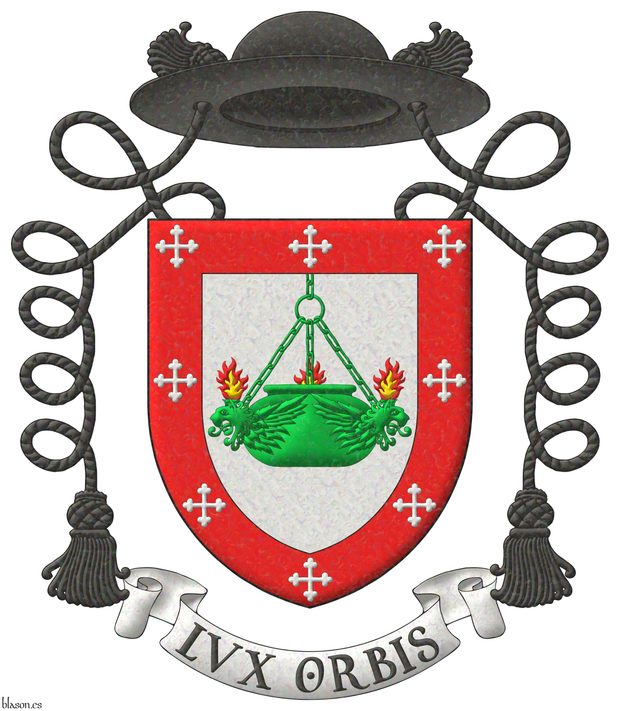
Argent, a suspended oil lamp of three lions' heads erased and winged Vert, two heads visible, enflamed proper; a bordure Gules, charged with eight crosses botonny Argent. Crest: A galero with two cords, one on each side, each with a tassel Sable. Motto «Lux Orbis».
Escudo de plata, pendiente del jefe una lampara de aceite de tres cabezas de león arrancadas y aladas de sinóple; una bordura de gules cargada de ocho cruces botonadas de plata. Timbrado de un galero con cordones y una borla a cada lado de sable. Lema «Lux Orbis»
Coat of arms emblazoned by me, highlighted with lights and shadows, outlined in Sable, with a pointed outer contour and with a iridescent finishing.
Blazon keywords: Argent, Vert, Gules, Sable, One, Three, Two, Eight, Suspended, Oil lamp, Lion, Head, Erased, Winged, Visible, Enflamed, Proper, Bordure, Charged, Cross botonny, Crest, Galero, Cord, Tassel and Motto.
Style keywords: Outlined in sable, Illuminated, Pointed and Iridescent.
Classification: Religious, Interpreted, Boa and Coat of arms.
Bearer: Iacobucci, Peter.


Philip Daubeny
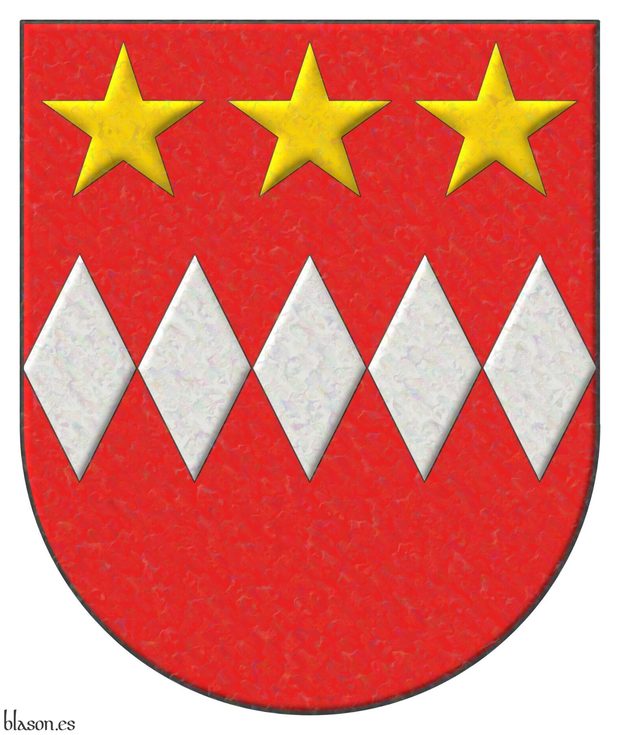
Philip Daubeny ~ Philip Daubeney.
Gules, a fess of five fusils Argent, in chief three mullets Or.
Escudo de gules, una faja de cinco fusos de plata, en jefe tres estrellas de oro.
Coat of arms interpreted in the following manner: the shape of the base is semicircular; the field is illuminated in Gules; the fusils outlined in Sable and illuminated in metal Argent; the fess is 5 fusils in length; the 3 mullets in chief of 5 points, outlined in Sable and illuminated in metal Or; and the whole with an iridescent finish.
This post corresponds to the English post number 61 in the same series.
Blazon keywords: Gules, Fusil, Argent, In fess, Mullet, Or and In chief.
Style keywords: Semi-circular, Illuminated, Outlined in sable and Iridescent.
Classification: Interpreted and Personal.
Bearer: Daubeny, Philip.


Rauf Daubeny
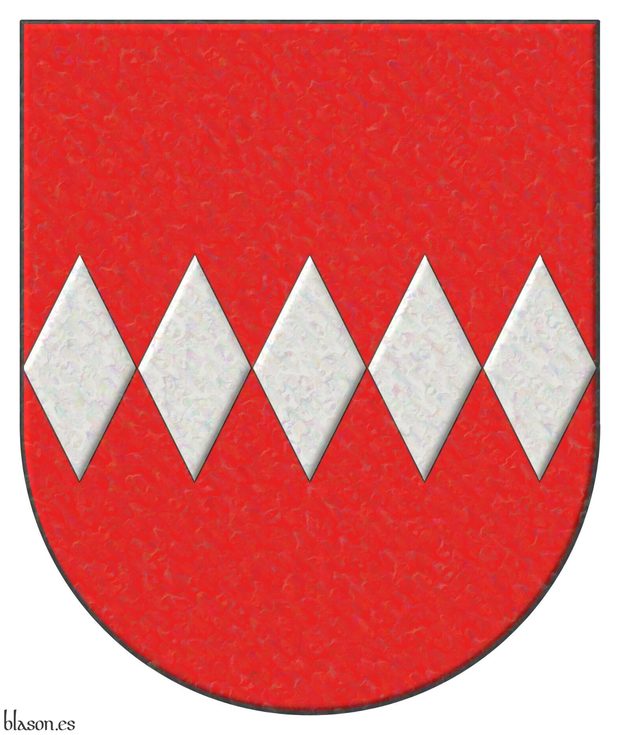
Ralph de Albini ~ Rauf de Albini.
Gules, a fess of five fusils Argent.
Escudo de gules, una faja de cinco fusos de plata.
Coat of arms interpreted in the following manner: the shape of the base is semicircular; the field is illuminated in Gules; the fusils outlined in Sable and illuminated in metal Argent; the fess is 5 fusils in length; and the whole with an iridescent finish.
I tend to blazon «Gules, a fess of five fusils Argent» ~ «Escudo de gules, una faja de cinco fusos de plata» which, as the piece called a fess touches the edges of the shield and is a unit, means the fusils touch the edges of the shield and touch each other, forming a single fess of 5.
While in the blazon «Gules, five fusils in fess Argent.» ~ «Escudo de gules, cinco fusos en faja de plata» the fusils neither touch each other nor the edges of the shield; this second blazon tells us that the fusils are «in fess» ~ «en faja», it does not tell us that they are forming a fess.
Blazon keywords: Gules, Fusil, Argent and In fess.
Style keywords: Semi-circular, Illuminated, Outlined in sable and Iridescent.
Classification: Interpreted and Personal.
Bearer: Daubeny, Rauf.


The King Charles III in Scotland

Quarterly: 1 and 4 Or, a lion rampant Gules, armed and langued Azure, within a double tressure flory counterflory Gules; 2 Gules, three lions passant, guardant, in pale Or, armed and langued Azure; 3 Azure, a harp Or, stringed Argent.
Escudo cuartelado: 1o y 4o de oro, un león de gules, armado y lampasado de azur, encerrado en un trechor doble flordelisado y contraflordelisado de gules; 2o de gules, tres leopardos en palo de oro, lampasados y armados de azur; 3o de azur, un arpa de oro cordada de plata.
Arms painted by me, illuminated with lights and shadows, outlined in Sable, with an ogee external shape and with a iridescent finishing.
Coat of arms of His Majesty King Charles III in Scotland emblazoned by me.
Blazon keywords: Gules, Or, Azure, One, Three, Quarterly, Leopard, Pale, Armed, Langued, Lion, Rampant, Double tressure, Flory, Counterflory, Harp and Stringed.
Style keywords: Outlined in sable, Illuminated, Ogee and Iridescent.
Classification: Personal, Interpreted, Boa and Coat of arms.
Bearer: Charles III of the United Kingdom.
-
Language
-
Categories of heraldry
-
Divisions of the field
- Without divisions
- Party per pale
- Party per fess
- Party per bend
- Party per bend sinister
- Tierce
- Tierce sinister
- Tierced per pale
- Tierced per fess
- Tierced per bend
- Tierced pallwise inverted
- Quarterly
- Quarterly per saltire
- Gyronny
- Party per fess, the chief per pale
- Party per pale, the sinister per fess
- Party per fess, the base per pale
- Party per pale, the dexter per fess
- Chapé
- Chaussé
- Embrassé
- Contre-embrassé
- Party per chevron
- Enté
- Enté en point
- Flanched
-
Metals
-
Colours
-
Furs
-
Other tinctures
-
Ordinaries and sub-ordinaries
-
Diminutives of the ordinaries
-
Geometric charges
-
Composite ordinaries
-
Inanimate charges from Nature
Atom, Crescent, Diamond, Emerald, Estoile, Increscent, Lightning flash, Moon, Mount, Mullet, Mullet of four points, Orbital, Plough of Ursa Major, Rainbow, Ray of the sun, River, Sea, Snowflake, Sun, Sun in splendour, Sun of May, Trimount, Water and Wave.
-
Vegetal charges from Nature
Acorn, Apple, Apple tree, Ash, Bluebonnet, Camellia, Chrysanthemum, Cinquefoil, Cornflower, Dogwood flower, Double rose, Elm, Fleur de lis, Flower, Gourd, Holm oak, Hop cone, Indian paintbrush, Kapok tree, Laurel, Lily, Linden, Lotus flower, Madonna lily, Mexican cedar tree, Oak, Olive tree, Palm tree, Plantain plant, Pomegranate, Poplar leaf, Rose, Shamrock, Sunflower, Thistle, Tree, Tulip, Vine and Wheat.
-
Animal charges from Nature
Badger, Bald eagle, Barbel, Barn owl, Bear, Beaver, Bee, Beetle, Bighorn sheep, Binson, Blackbird, Boar, Brach hound, Bull, Doe, Dog, Dolphin, Dove, Eagle, Elephant, Falcon, Female figure, Fish, Flame, Fly, Fox, Frog, Goat, Goldfinch, Goose, Heron, Horse, Hummingbird, Jaguar, Lark, Leopard, Lion, Lion passant, Lion rampant guardant, Lioness, Lynx, Male figure, Martlet, Merino ram, Owl, Panther, Parrot, Peacock, Pelican, Pelican in her piety, Pronghorn, Puffin, Quetzal, Raven, Roe deer, Rooster, Savage, Seagull, Serpent, She-wolf, Stag, Starling, Talbot, Turtle, Tyger, Vulture, Warren hound and Wolf.
-
Parts of natural charges
Arm, Beak, Branch, Caboshed, Chest, Claw, Covert, Dorsal fin, Eagle claw, Ear of wheat, Ermine spot, Escallop, Feather, Foot (palmiped), Foreleg, Forepaw, Hand, Head, Heart, Hoof, Leaf, Neck, Ostrich feather, Palm frond, Paw, Roe deers' attires, Shoulder, Sprig, Stags' attires, Stem, Swallow-tail, Tail, Tail addorsed, Tail fin, Talon, Tibia, Tooth, Trunk, Trunk (elephant), Two hands clasped, Two wings in vol, Udder, Wing and Wrist.
-
Artificial charges
Ace of spades, Anchor, Anvil, Arch, Arm vambraced, Armillary sphere, Arrow, Axe, Bell, Bell tower, Beret, Bonfire, Book, Bookmark, Bow, Branding iron, Bridge, Broken, Buckle, Cannon, Cannon dismounted, Cannon port, Canopy roof, Carbuncle, Castle, Celtic Trinity knot, Chain, Chess rooks, Church, Clarion, Clay pot, Closed book, Club, Column, Comb, Compass rose, Conductor's baton, Cord, Covered cup, Crozier, Crucible, Cuffed, Cup, Cyclamor, Dagger, Double vajra, Drum, Ecclesiastical cap, Fanon, Federschwert, Fleam, Four crescents joined millsailwise, Galician granary, Garb, Gauntlet, Geometric solid, Grenade, Halberd, Hammer, Harp, Host, Hourglass, Key, Key ward, Knight, Knot, Lantern, Letter, Line, Loincloth, Menorah, Millrind, Millstone, Millwheel, Monstrance, Mortar, Mullet of six points pierced, Nail, Non-classic artifact, Norman ship, Number, Oar, Oil lamp, Open book, Page, Pair of scales, Parchment, Pestle, Piano, Pilgrim's staff, Plough share, Polish winged hussar, Port, Portcullis, Potent, Quill, Ribbon, Rosette of acanthus leaves, Sabre, Sackbut, Sail, Scroll, Scythe, Sheaf of tobacco, Ship, Skirt, Spear, Spear's head, Stairway, Star of David, Step, Sword, Symbol, Tetrahedron, Torch, Tower, Trident, Trumpet, Turret, Two-handed sword, Wagon-wheel, Water-bouget, Wheel, Winnowing fan and With a turret.
-
Immaterial charges
Angel, Archangel, Basilisk, Dragon, Dragon's head, Garuda, Golden fleece, Griffin, Heart enflamed, Justice, Mermaid, Our Lady of Mercy, Ouroboros, Paschal lamb, Pegasus, Phoenix, Sacred Heart of Jesus, Saint George, Sea-griffin, Trinity, Triton, Unicorn, Winged hand and Wyvern.
-
External elements
-
Heraldic creations
-
References
-
Formats
-
Keywords on this page
Port and windows, Proper, Azure, Boa, Bordure, Chain, Charged, Castle, Crest, Crown, Closed royal crown, Crowned, Cross, Quarterly, Four, Triple-towered, Outlined in sable, Two, In the fess point, In chief, In base, Coat of arms, Inescutcheon, Emerald, Mullet, Fleur de lis, Personal, Pomegranate, Gules, Leaved, Illuminated, Interpreted, Iridescent, Langued, Lion, Masoned, Semi-circular, Ordered, Or, Argent, Civic, Purpure, Rampant, Sable, Vert, Slipped, Three, One and Pallet.

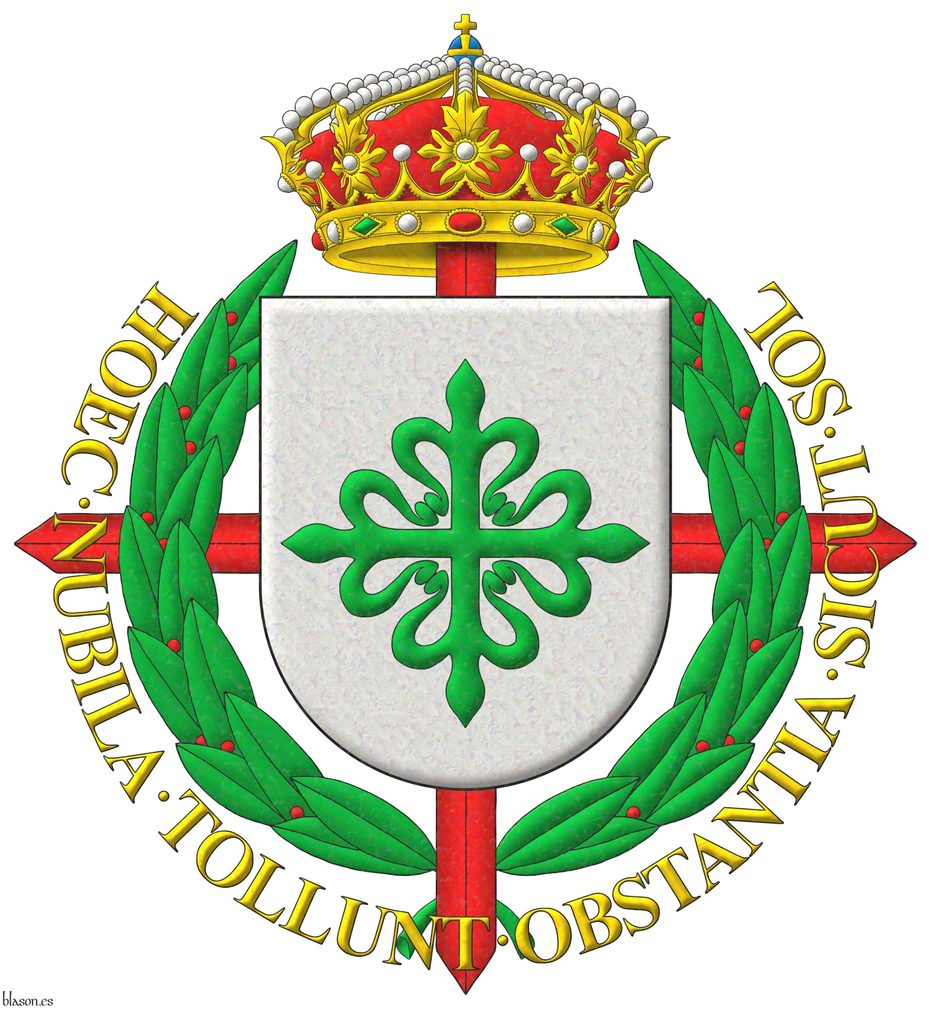
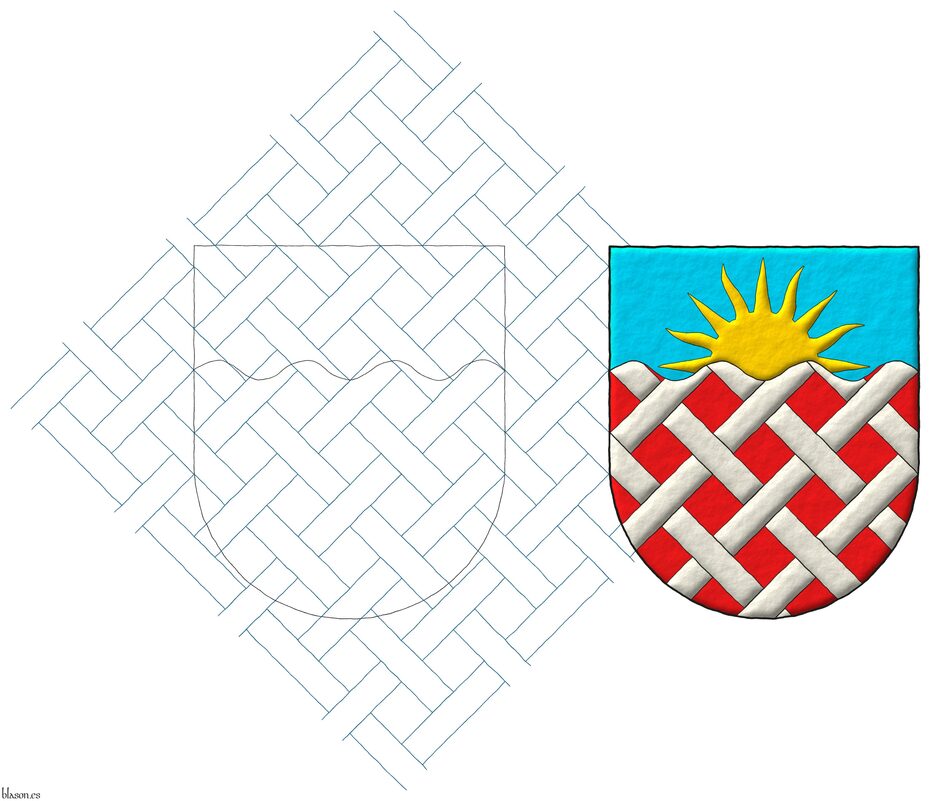
![Columns of the Kingdom of Spain Quarterly: 1 Gules, a castle triple-towered Or, port and windows Azure, masoned Sable [for Castile]; 2 Argent, a lion rampant Purpure, armed and langued Gules, crowned Or [for Leon]; 3 Or, four pallets Gules [for Aragon]; 4 Gules, a chain orlewise, crosswise, and saltirewise Or, charged in the fess point with an emerald Vert [for Navarre]; enté en point Argent, a pomegranate proper, seeded Gules, slipped and leaved Vert [for Granada]; an inescutcheon Azure, three fleurs de lis Or, 2 and 1, a bordure Gules [for Bourbon]. Crest: A closed royal crown. Supporters: two columns Argent, capital and base Or, between in base waves Azure, in chief an imperial crown the dexter and a closed royal crown the sinister. Moto environing the columns and behind the shield: «Plus Ultra» Or over a scroll Gules.](../escudo_armas/EspanaR.25.Soportes.Irisado.Avr20.jpg)
![Lineage Mark of Germany, collage [ Or, a fess chequey Gules and Argent ] · [ Or, a fess chequey Azure and Argent ] · [ Gules, a fess chequey Azure and Argent ] · [ Gules, a fess chequey Azure and Argent ] · [ Azure, a fess chequey Gules and Argent ].](../escudo_armas/MarkAlemania.19.Collage.English.Irisado.Avr20.jpg)